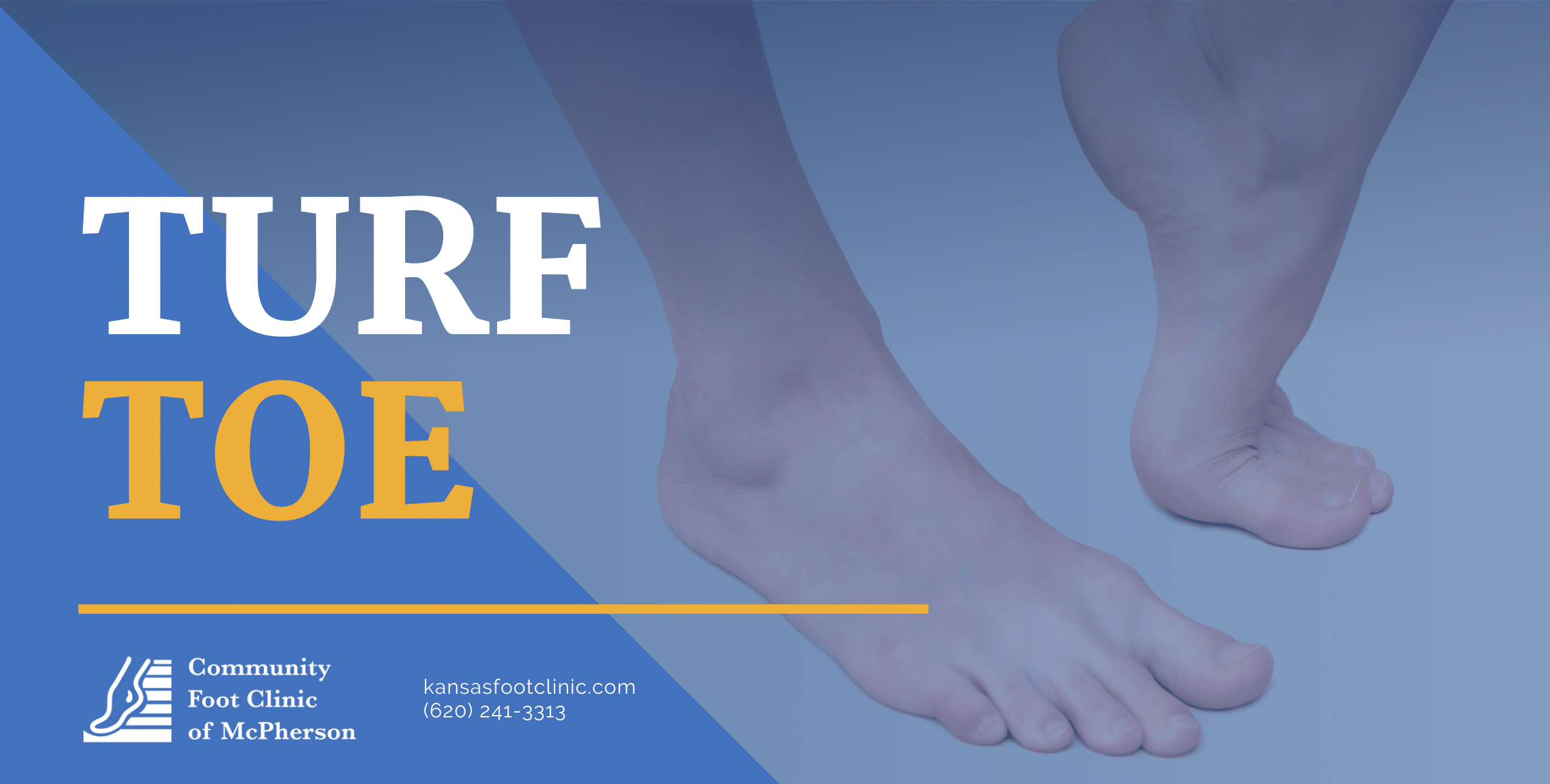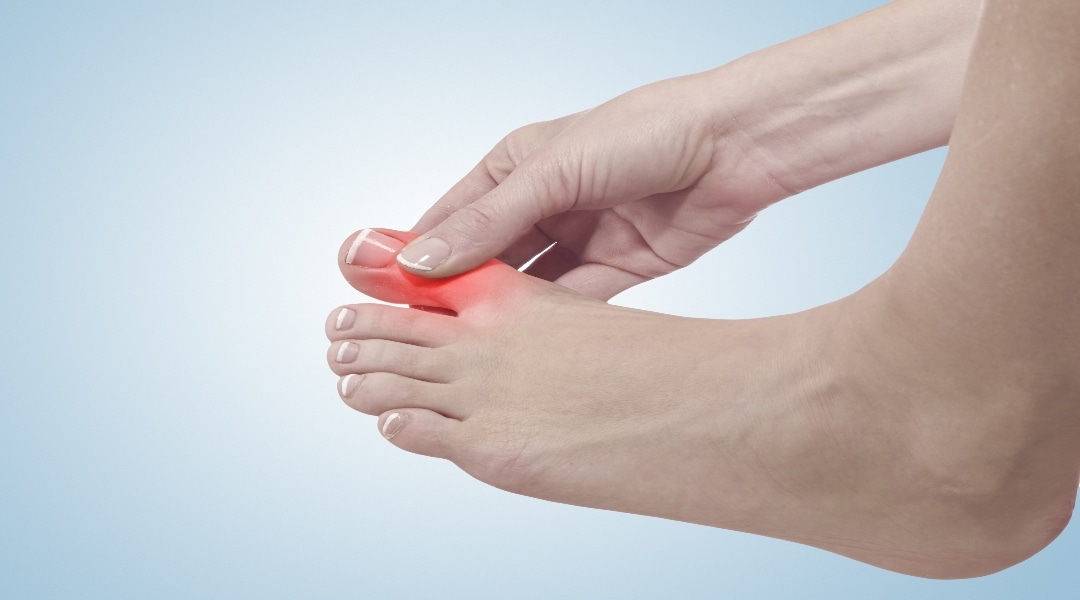Turf Toe – Sprain of the Big Toe
Turf toe is one of those sports injuries that are so closely associated with a specific circumstance that its name tells you everything you need to know.
In this case, it suggests trauma to the toe as the result of repetitive stress while playing on artificial turf. But while there is some truth to the name – turf toe really is more common with athletes who play on artificial turf – you don’t have to play football (or even be an athlete) to suffer from this painful condition.
In the following, we’ll break down everything you need to know about turf toe, including its causes, symptoms, and treatment options.

What is Turf Toe?
Turf toe is a sprain or strain of the big toe joint (medically known as the metatarsophalangeal joint, or MTP). It is located where the big toe meets the foot and is held together by ligaments, tendons, and other tissues.
When the big toe joint is hyperextended – forced beyond its normal range of motion – the ligaments around the MTP can become stretched or torn, causing a sprain. This can happen when the toe is forcefully bent upward, such as when a football player’s cleat gets caught in the turf.
A strain occurs when the tendons or other soft tissues around the joint are stretched or torn. This can happen when the toe is forcefully dorsiflexed, such as when a ballet dancer stands on her toes.
Turf toe can range from a mild sprain or strain to a complete tear of the ligaments or tendons around the MTP. In severe cases, the joint can become dislocated.
Turf toe is a common injury in football and soccer, but it can also occur in other sports that involve running and jumping, such as basketball, tennis, and track. It can also occur in non-athletes who wear shoes that are too tight or have high heels, or who participate in activities that put stress on the MTP joint, such as dancing.
What Are the Symptoms of Turf Toe?
Turf toe can be characterized by a few main symptoms:
Pain
While usually most intense at the moment of injury, turf toe pain can range from mild to severe. It is often described as a sharp, burning sensation. In more severe cases, the pain can be intense enough to limit your ability to walk or put weight on the affected foot.
Swelling
There may be some initial swelling around the MTP joint, which can make the toe feel stiff.
Tenderness
The toe may be painful to the touch.
Bruising
There may be some bruising around the MTP joint, which sometimes becomes more apparent a day or two after the initial injury.
Instability
You may feel like the joint is “giving way” or that the toe is not as secure as it should be. This is more common in severe cases where the ligaments or tendons around the joint are completely torn.
A “Popping” Sound at the Time of Injury
In some cases, people report hearing a “popping” sound when the injury occurs. This is usually an indication of a more serious injury, such as a complete ligament tear or dislocation.
Stiffness and Inability to Move the Toe
In severe cases, the toe may be so stiff that you are unable to move it. This is usually an indication of a complete ligament tear.
It’s important to note that not all of the abovementioned symptoms need to be present for a turf toe diagnosis. Cases can vary based on cause and severity, and it’s entirely conceivable to see two patients with turf toe who have completely different symptom profiles.
What Causes Turf Toe?
Turf toe is a common injury in football and other contact sports played on artificial turf, but it can also occur in any activity that puts stress on the big toe joint.
The most common cause of turf toe is forceful dorsiflexion – when the toe is forced upwards beyond its normal range of motion. This can happen when the toe gets caught in the turf, as is often seen in football players, or when landing from a jump, as is common in basketball players.
Other causes of turf toe include:
- Wearing shoes that are too tight or have high heels, which can force the toe into an unnatural position.
- Participating in activities that put stress on the big toe joint, such as dancing.
- Having flat feet or high arches, which can predispose you to the condition.

Does Turf Toe Need Treatment?
Yes! Always!
Some people think that because turf toe is “just” a toe injury, that nothing can really be done for it or that professional treatment isn’t really worth pursuing. This simply isn’t true.
While some cases of turf toe can ultimately be managed with home care, it is always best to get a proper evaluation and treatment guidelines from a professional. In fact, this is true for any type of sprain, especially in the ankle!
Without proper treatment, sprains have a higher risk of developing into more complex problems with longer-lasting symptoms, including chronic pain or instability. Having a thorough evaluation can help identify any potential complications so they can be addressed.
How is Turf Toe Treated?
The most common conservative treatment for turf toe is RICE therapy, especially when the injury is mild. Following a regimen of rest, icing, compression, and elevation can help many patients return to normal activity within 2-3 weeks.
We might also recommend MLS laser therapy to help relieve pain faster and accelerate the body’s natural healing process. Laser therapy is a great option for workers, athletes, and other active patients who want to get back to action faster.
Athletic tape is also often used to immobilize and relieve pressure from the injured joint during the recovery process, and anti-inflammatory pain relievers may also be suggested. Once healing is nearly complete, physical therapy exercises might be recommended to restore strength and flexibility in the toe joint.
If turf toe is severe and conservative treatments are not effective, surgical repair may be considered. The need for surgery is rare, and usually arises only if there is severe ligament tearing.
Lowering Your Risk of Turf Toe
Although it’s impossible to guarantee any sports injury will never happen, simple steps can greatly reduce your risk of turf toe. They include:
- Wearing quality, sport-specific shoes. A stiffer-than-average sole can help protect those who are more vulnerable to turf toe.
- Wearing an appropriate set of arch supports or custom orthotics. Dr. Timson can analyze your gait and foot shape to determine whether you could benefit from supports or inserts.
- Using athletic tape around the toe when you play.
- Avoiding overuse mistakes, such as too much high-impact exercise for too many days in a row. Wisely incorporate cross-training and rest days to prevent overstrain.
Get the Relief You Need for Any Toe Injury
Turf toe is an injury that should always be evaluated and treated promptly. The sooner it can be properly addressed, the lower the risk that it will get worse or keep you from doing the activities you love.
Dr. Trent Timson has extensive experience helping athletes prevent and recover from all kinds of sports injuries, including turf toe. He’s helped athletes of all ages and levels, and he can help you, too!
Schedule an appointment by giving us a call or by filling out our online contact form.
McPherson Office
316 W. 4th Street
McPherson, KS 67460
P: (620) 241-3313
F: (620) 241-6967
© Community Foot Clinic of McPherson. All Rights Reserved.
Privacy Policy | Terms & Conditions
Web Design by CP Solutions
Marketed by VMD Services
